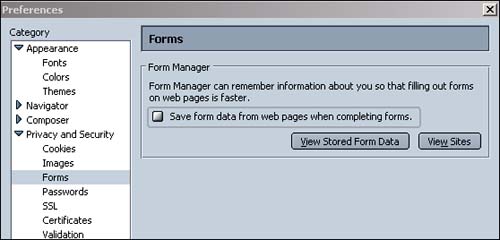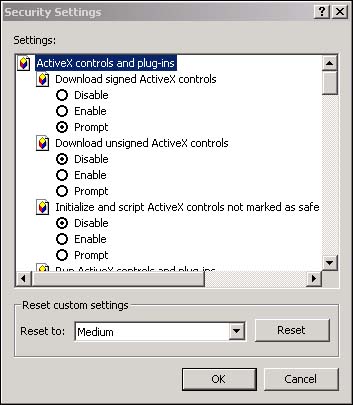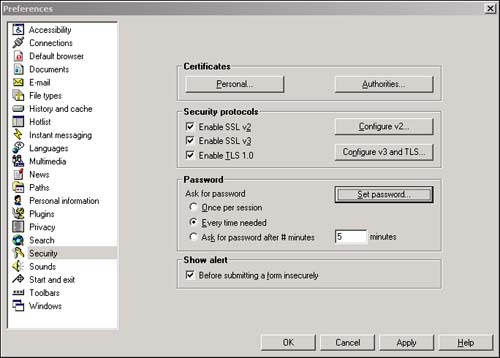Implementing Controls
As we have seen, your Web browser is a major source of problems your kids can face online. Surfing Web sites has become a popular pastime. Just about any information you want can be found in a Web site. In three of the major browsers, we will look at controls that parents can use to help protect their children. Following are the three browsers we will look at:
Netscape 6.1 (www.netscape.com)
Internet Explorer 6.1 (www.microsoft.com)
Opera 5.12 (www.opera.com)
Netscape 6.1
You can enable several controls to protect the privacy of your children when they (and you!) are surfing online. We have discussed some of the controls earlier, and this will rehash what they are. The following granular controls can be implemented.
Disable cookies by selecting Edit, Preferences, Privacy and Security, Cookies, as shown in Figure 15.1.
Figure 15.1. Disabling cookies.

Disable saving form information such as name and address by selecting Edit, Preferences, Privacy and Security, Forms and then unchecking the check box, as shown in Figure 15.2.
Figure 15.2. Disable caching of form information.

Disable storing Web site passwords and enable encryption on any stored information by selecting Edit, Preferences, Privacy and Security, Passwords. Uncheck the Remember Passwords box and check the Use Encryption box, as shown in Figure 15.3.
Figure 15.3. Do not save passwords, but do use encryption.

Enable SSL and SSL warnings for data being encrypted or not being encrypted when it is sent through forms by selecting Edit, Preferences, Privacy and Security, SSL, as shown in Figure 15.4. This will tell you when the information you transmit over the Internet is encrypted and safe from capture by malicious attackers. TLS is based on SSL and provides privacy and data integrity between two communicating applications.
Figure 15.4. SSL enabled with warnings turned on.

Disable Java and JavaScript by selecting Edit, Preferences, Advanced, as shown in Figure 15.5; remember, however, that doing so can cause some Web site functionality to be disabled that you might want. By disabling Java and JavaScript, you reduce the risk that a malicious script on a Web site will steal information from your computer or perform some function on your computer that you do not allow when you surf a Web site.
Figure 15.5. Disable Java and JavaScript.

Internet Explorer 6.1
Much like Netscape, Internet Explorer has many built-in controls, as we have discussed previously. Some additional controls that you can implement can limit the data saved and sent to others on the Internet.
Limit the temporary files stored on the computer by selecting Tools, Internet Options, General, Settings, as shown in Figure 15.6. If you store a lot of temporary files on your computer and your computer gets compromised, the attacker can see where you have been surfing and build a profile of all your preferences. Someone else who shares your computer in your home would also be able to see where you have been surfing, and that might be personal information.
Figure 15.6. Reduce the cache size of the browser.

You can enable the history of sites visited to see what sites your child has surfed by selecting Tools, Internet Options, General. You also can specify how long you want to keep a history of Web site use.
Internet Explorer has some additional controls over programming languages other than Java and JavaScript. With the controls under Tools, Internet Options, General, Security, Custom Settings, as shown in Figure 15.7, you can disable more functions that could be harmful to your child's Web surfing. Under this option, you should select Disable or ask for the browser to prompt the user for input. Programming languages that can interact with your computer through Web sites can do anything they want to your computer because programming languages are very powerful and can take advantage of any information you give them. Some of the options you should set include the following:
Download Signed ActiveX Controls—Enable
Download Unsigned ActiveX Controls—Disable
Initialize and Script ActiveX Controls Not Marked as Safe—Disable
Run ActiveX Controls and Plug-Ins—Disable
Script ActiveX Controls Marked Safe for Scripting—Enable
Java Permissions—Disable
Installation of Desktop Items—Prompt
Launching Programs and Files in an IFRAME—Disable
Software Channel Permissions—High Safety
Submit Unencrypted Form Data—Disable
Userdata Persistence—Disable
Active Scripting—Disable
Scripting of Java Applets—Disable
Figure 15.7. Disable ActiveX and Java functionality.

You can enable more security over the use of cookies by selecting Tools, Internet Options, General, Privacy, as shown in Figure 15.8. You can set the option to High to block most cookies or Advanced to block all cookies.
Figure 15.8. Disable most cookies with the High setting.

A unique feature to Internet Explorer is its Content Advisor. This function checks the content of Web sites for such things as nudity, foul language, sexual activity, and violence. It performs some of the functionality of third-party software. You can set these options by selecting Tools, Internet Options, Content-Enable, Ratings, as shown in Figure 15.9. These settings are termed the Recreational Software Advisory Council (RSACi) ratings. You can set the four settings (Language, Nudity, Sex, and Violence) to the highest level for the most protection. As mentioned earlier, these might block access to sites that you want to visit.
Figure 15.9. Content Advisor settings, set to the highest level.

You can add sites that you do not want blocked by selecting Tools, Internet Options, Content, General. You also can password-protect the Content Advisor so that your kids cannot change the content-checking options.
Additional security controls dealing with certificates and SSL authentication can be set by selecting Tools, Internet Options, Content, Advanced, as shown in Figure 15.10. You can select the check boxes to enable these security measures.
Figure 15.10. Advanced security settings for SSL and certificates.

Opera 5.12
One of the main features of the Opera browser is its speed. The other functionality, such as the Content Advisor from Internet Explorer, is not present; however, you can still set many security options.
By selecting File, Preferences, History and Cache, you set up the cache to save the browsing that your child has been doing online so that you can go through the saved cache and see what sites were viewed, as shown in Figure 15.11.
Figure 15.11. Setting the history and cache size.

To protect your child from sending form data inadvertently, keep the Personal Information form blank, as shown in Figure 15.12. This option can be set through File, Preferences, Personal Information.
Figure 15.12. Blank personal information form.

You can increase the security options for cookies by selecting File, Preferences, Privacy, as shown in Figure 15.13. You can block all cookies or accept cookies only from the server to which you are connecting. On exiting, you can have the browser throw away cookies and display warning messages.
Figure 15.13. Disable cookies.

Opera has the capability to password-protect the security features that you have set. You do not want your kids to change your security options after you have set them. Through File, Preferences, Security, you can set a password as well as enable and configure SSL and certificates, as shown in Figure 15.14. You can use the setting shown in Figure 15.14 to set up your security.
Figure 15.14. SSL, certificates, and password setting.

